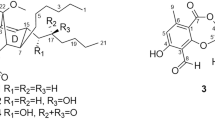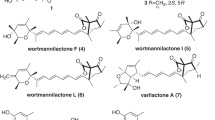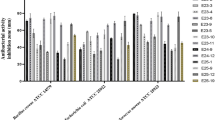Abstract
Three new polyketides, (2S)-2,3-dihydro-5,6-dihydroxy-2-methyl-4H-1-benzopyran-4-one (1), (2′R)-2-(2′-hydroxypropyl)-4-methoxyl-1,3-benzenediol (2), and 4-ethyl-3-hydroxy-6-propenyl-2H-pyran-2-one (3) were isolated from the culture broth of Colletotrichum gloeosporioides, an endophytic fungus derived from the mangrove Ceriops tagal. The structures of 1–3 were elucidated on the basis of NMR spectra and HR-ESI-MS data. Their absolute configurations were determined by comparing with the experimental and calculated ECD spectrum. Compounds 1 and 3 showed potent antibacterial activities against some of the tested microbes.
Similar content being viewed by others
Log in or create a free account to read this content
Gain free access to this article, as well as selected content from this journal and more on nature.com
or
References
Gao J-M, Yang Sh-X, Qin J-Ch. Azaphilones: chemistry and biology. Chem Rev. 2013;113:4755–811.
Linnakoski R, Reshamwala D, Veteli P, Cortina-Escribano M, Vanhanen H, Marjomäki V. Antiviral agents From fungi: diversity, mechanisms and potential applications. Front Microbiol. 2018;9:1–18.
Deshmukh SK, Prakash V, Ranjan N. Marine fungi: a source of potential anticancer compounds. Front Microbiol. 2018;8:1–24.
Masi M, Maddau L, Linaldeddu BT, Scanu B, Evidente A, Cimmino A. Bioactive metabolites from pathogenic and endophytic fungi of forest trees. Curr Med Chem. 2018;25:208–52.
Ibrahim SRM, Mohamed GA, Al Haidari RA, El-Kholy AA, Zayed MF, Khayat MT. Biologically active fungal depsidones: chemistry, biosynthesis, structural characterization, and bioactivities. Fitoterapia. 2018;129:317–65.
Macias-Rubalcava M, Sanchez-Fernandez RE. Secondary metabolites of endophytic xylaria species with potential applications in medicine and agriculture. World J Microbiol Biotechnol. 2017;33:1–22.
Kellogg JJ, Raja HA. Endolichenic fungi: a new source of rich bioactive secondary metabolites on the horizon. Phytochem Rev. 2017;16:271–93.
Ancheeva E, Daletos G, Proksch P. Lead compounds from mangrove-associated microorganisms. Mar Drugs. 2018;16:1–31.
Agrawal S, Adholeya A, Barrow CJ, Deshmukh SK. Marine fungi: an untapped bioresource for future cosmeceuticals. Phytochem Lett. 2018;23:15–20.
Wang MY, Zhou ZS, Wu JY, Ji ZR. Comparative transcriptome analysis reveals significant differences in gene expression between appressoria and hyphae in Colletotrichum gloeosporioides. Gene. 2018;670:63–69.
Chapla VM, Zeraik ML, Leptokarydis IH, Silva GH. Antifungal compounds produced by Colletotrichum gloeosporioides, an Endophytic Fungus from Michelia champaca. Molecules. 2014;19:19243–52.
Garcia-Pajon CM, Collado IG. Secondary metabolites isolated from Colletotrichum species. Nat Prod Rep. 2003;20:426–31.
Wang F, Liu JK. A pair of novel heptentriol stereoisomers from the ascomycete Daldinia concentrica. Helv Chim Acta. 2004;87:2131–4.
Frisch MJ, Trucks GW, Schlegel HB, et al. Gaussian 09 (Revision A.02). Wallingford, CT: Gaussian Inc.; 2009 .
Bruhn T, Schaumloffel A, Hemberger Y, Pescitelli G. SpecDis, Version 1.71. Berlin, Germany; 2017, http://specdis-software.jimdo.com.
Correa H, Aristizabal F, Duque C, Kerr R. Cytotoxic and antimicrobial activity of pseudopterosins and seco-pseudopterosins isolated from the octocoral Pseudopterogorgia elisabethae of san andres and providencia islands (Southwest Caribbean Sea). Mar Drugs. 2011;9:334–44.
Acknowledgements
This work was supported by the Foundation for the National Natural Science Foundation of China (No. 21662012) and Program for Innovative Research Team in University (No. IRT-16R19).
Author information
Authors and Affiliations
Corresponding author
Ethics declarations
Conflict of interest
The authors declare that they have no conflict of interest.
Additional information
Publisher’s note: Springer Nature remains neutral with regard to jurisdictional claims in published maps and institutional affiliations.
Supplementary information
Rights and permissions
About this article
Cite this article
Luo, YP., Zheng, CJ., Chen, GY. et al. Three new polyketides from a mangrove-derived fungus Colletotrichum gloeosporioides. J Antibiot 72, 513–517 (2019). https://doi.org/10.1038/s41429-019-0178-8
Received:
Revised:
Accepted:
Published:
Issue date:
DOI: https://doi.org/10.1038/s41429-019-0178-8
This article is cited by
-
The hidden diversity of mangrove endophytic fungi from Tanzania: insights from a preliminary study
Biologia (2024)
-
Antimicrobial compounds from marine fungi
Phytochemistry Reviews (2021)



